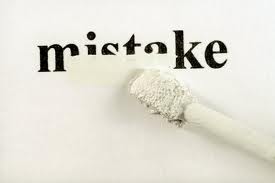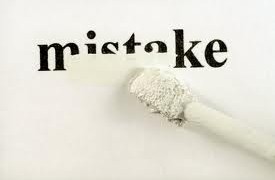The new economy has claimed many business casualties in the last few years. Unfortunately most of these casualties have been a result of self-inflicted leadership mistakes. Making mistakes in this tough economy can have devastating results including loss of sales, profits, key employees and customers.
This article describes seven leadership mistakes that leaders make that are as avoidable as they are devastating. Like the captain of the cruise ship Contra Concordia the tragedy didn’t occur because the captain didn’t know better. It happened because of his decisions and actions. Don’t be that Leader!
As you read each article remember every CEO who has made these mistakes thought to themselves, “This could never happen to us!” It did and it will happen to your company if you don’t take the appropriate action to prevent it.
1. Unclear or Misaligned Mission, Vision and Values and Culture
In turbulent times it’s imperative that organizations have a clear sense of direction and purpose. Not having everyone on the same page can result in chronic organizational dysfunction where employees and departments are working at cross purposes by pursuing conflicting goals. Remember every misalignment dissipates your company’s ITEAM (Information, Time, Energy, Attention and Motivation) and drains your profits.
Are your company’s Culture, Mission, Vision and Values aligned so that everybody in the organization understands and acts congruently with them?
2. Focusing on the Wrong Who
What you don’t know about your customers is putting your business at risk. Why? Because market trends and customer needs are changing more rapidly than ever before. If you don’t know who your ideal customers are, as well as how, when and why they are motivated to purchase your solution, you can’t position your solution to uniquely satisfy their needs.
When your customers’ needs shift how quickly can you re-align your company to serve those needs? If you don’t take care of your customer someone else will. To survive many businesses have resorted to discounting, coupons and promotions to attract customers. What they found was that the customers left as soon as the promotion ended or the coupons expired. They didn’t acquire customers they merely leased them. This is not a long-term sustainable strategy.
What are you doing to identify your ideal customers and make sure you know them well enough to predict their behavior?
3. Having a Solution that’s Just “Good Enough”
In the past companies could survive and even thrive by having “me too” products or services that were good, but not great. Customers were plentiful, less informed and not as discriminating. Today customers are more informed (thanks to the Internet), more demanding (due to more choices) and more discriminating (thanks to tighter budgets and more scrutiny on every purchase decision). Customers are looking for solutions to their problems (both technical and emotional). They want companies who will help them make the right decision now and in the future. Therefore the stakes are higher. Your solution must uniquely meet your ideal customer’s buying criteria and emotional needs.
Can you deliver a Solution that uniquely meets your Ideal Customer’s buying criteria and emotional needs?
4. Having your message lost in the noise of the marketplace
Having your message heard is a function of the media, message, timing, frequency and delivery. A recent LinkedIn survey revealed that the number-one challenge on the minds of sales professionals was “getting the attention of prospects”*. Customers are bombarded with information, so much so that everything begins to sound like “Blah, Blah, Blah”. Making matters more challenging is the fact that only 3% of your target market is in the buying mode at a given point in time. If they aren’t buying they aren’t listening. Getting your message to your customers too early, too late or without impact is a waste of time, money and energy.
How does your message help your Ideal Customers clearly understand how your solution uniquely satisfies their buying criteria and emotional needs; and is delivered when it will most influence the buying decision in your favor?
5. Not delivering enough value
Since the recession started, many salespeople and companies alike are complaining that all their customers want is a lower price. If this were true everyone would drive a Kia, live in a one-bedroom condo watching TV on a 26-inch TV and never eat dinner at a restaurant.
Price is never the top priority unless there isn’t enough value provided. If customers understand the differences you provide and value those differences they will pay the price. If they don’t understand the differences or don’t value it, they won’t pay. Remember customers always decide by differentiating. If you don’t differentiate your solution somebody else will. Don’t leave it to chance, or worse, the competition.
Does the Value delivered by your solution far exceed what your customers pay so that “price” is never the primary factor in the buying decision?
6. Delivering a customer experience that satisfies but doesn’t WOW
Customer experience is defined as the sum of all experiences a customer has with a supplier of goods or services, over the duration of their relationship with that supplier. This means every touch impacts that experience positively or negatively. Your ability to deliver an experience that sets you apart in the eyes of your customers serves to increase how much they spend with you and, optimally, inspire loyalty to your brand.
As evidenced by the number of business casualties over the past few years most companies talk about becoming customer focused, but few actually do it. Doing customer satisfaction surveys is one thing, changing the company’s culture based on what was learned from the surveys in something totally different.
Does your Customer Experience make sure that every Customer Touch reinforces your unique selling proposition and endears customers to your organization while transforming prospects to customers, customers into loyal customers and loyal customers into raving fans?
7. Mismanaging human capital
To succeed a leader must know the strengths and motivation of each person on the team, as well as how the individual impacts the performance of the team. Recognizing a person’s talent and then managing it creates a motivated and engaged workforce. Failure to hire the right people for the jobs and not putting people in positions where their talent can soar is a waste of a company’s resources.
Successful companies have specific plans for recruiting, interviewing, hiring and developing new employees. They also invest the time, energy and resources to develop employees for their current and future jobs.
Do you have the Right People in place so that their talents and motivation are fully utilized while executing your sales and marketing strategies?
A key concept behind the mistakes in this article is that they are interrelated and have a compounding effect on each other. For example, if your employees aren’t aligned with your Mission, Vision, Values and culture you’ll be hard pressed to have them deliver customer touches that are consistent with your unique selling proposition. If you have the right message but it’s delivered too early or too late, it won’t influence the sale in your favor or advance your strategy. If you spend selling effort and resources pursuing customers who don’t need, can’t or won’t buy your solution, your sales and profits will suffer. The key to success is to take action to avoid all the leadership mistakes and constantly monitor them to make sure they don’t become obstacles to growing sales, profits and customer loyalty.


